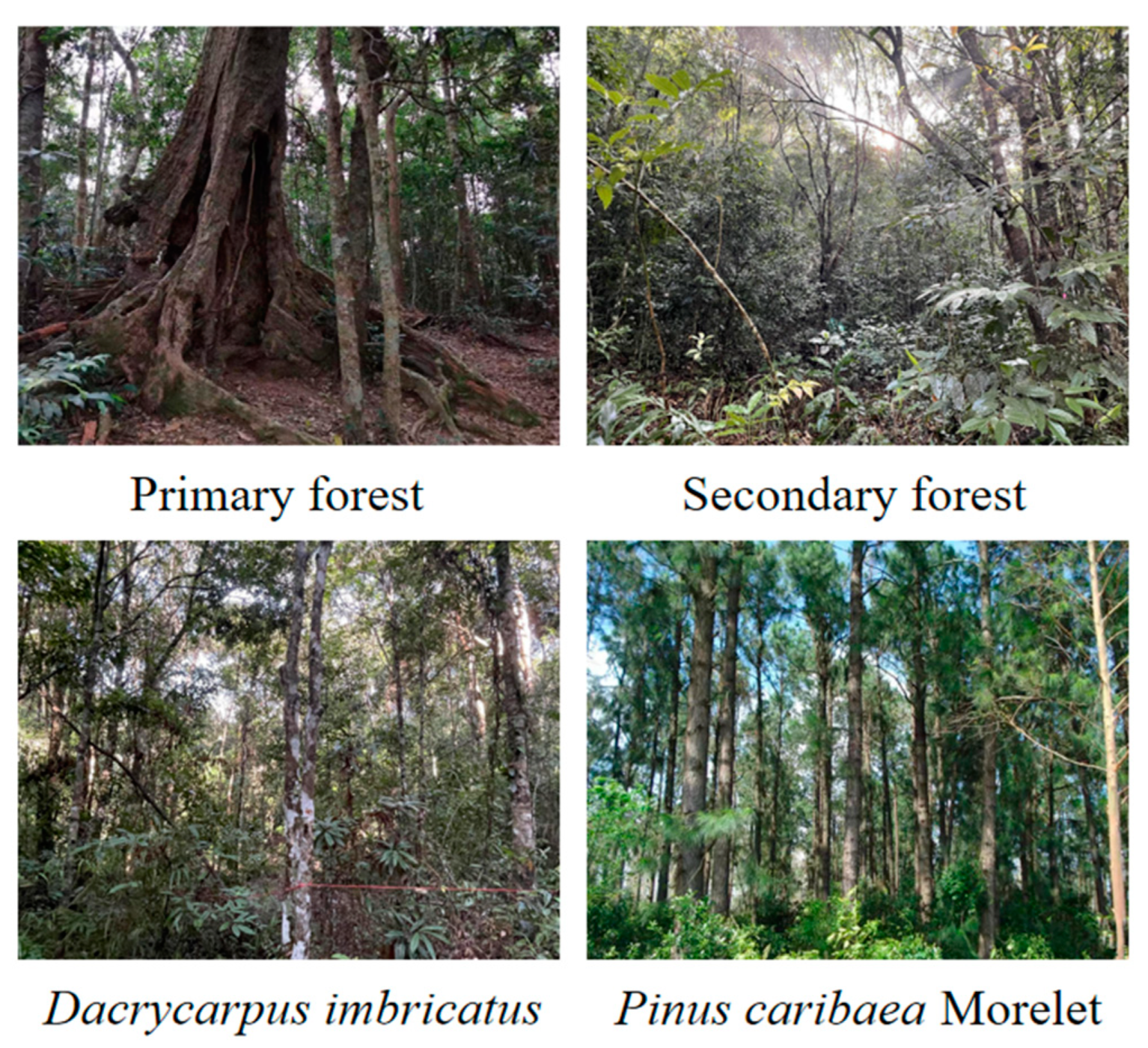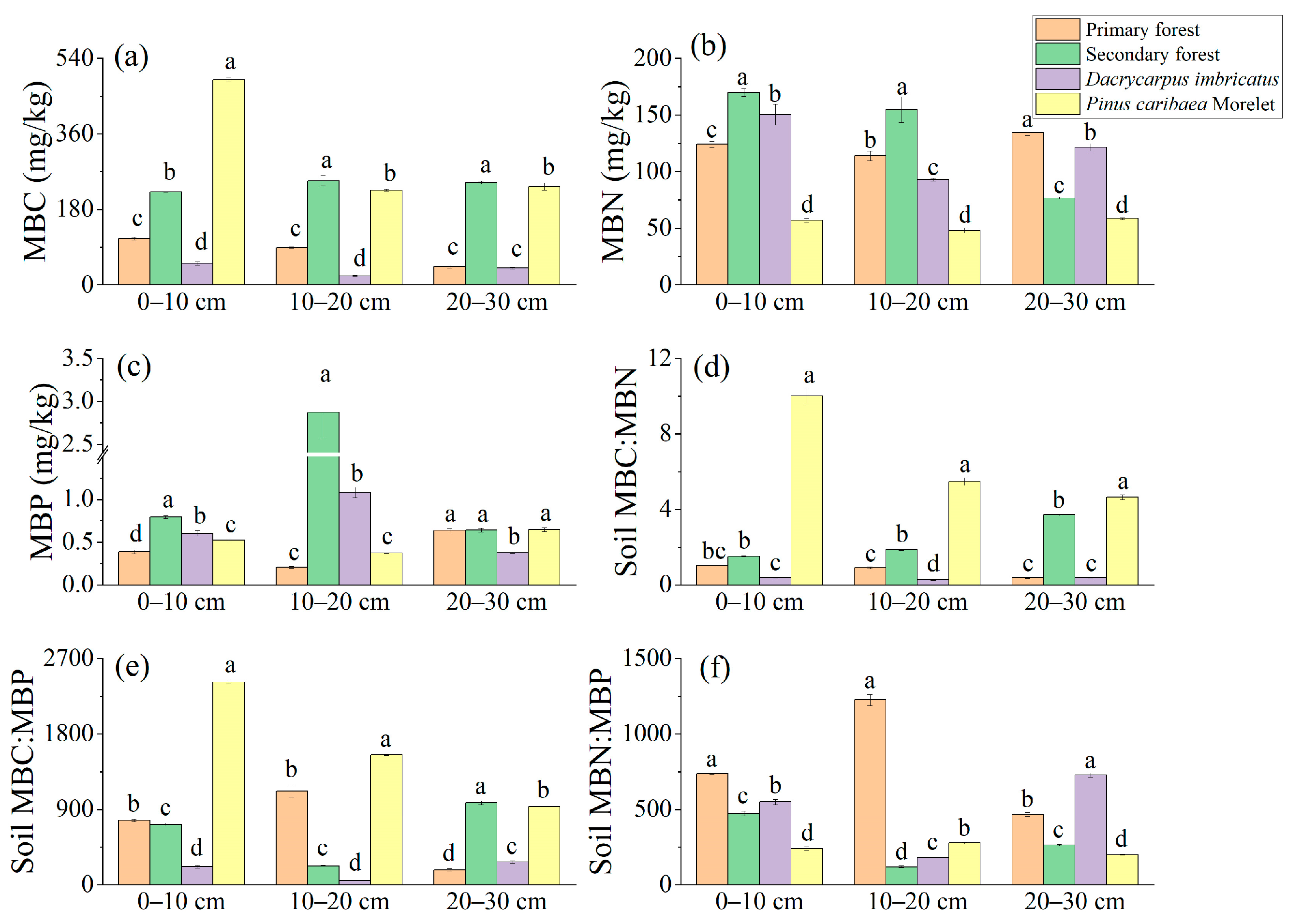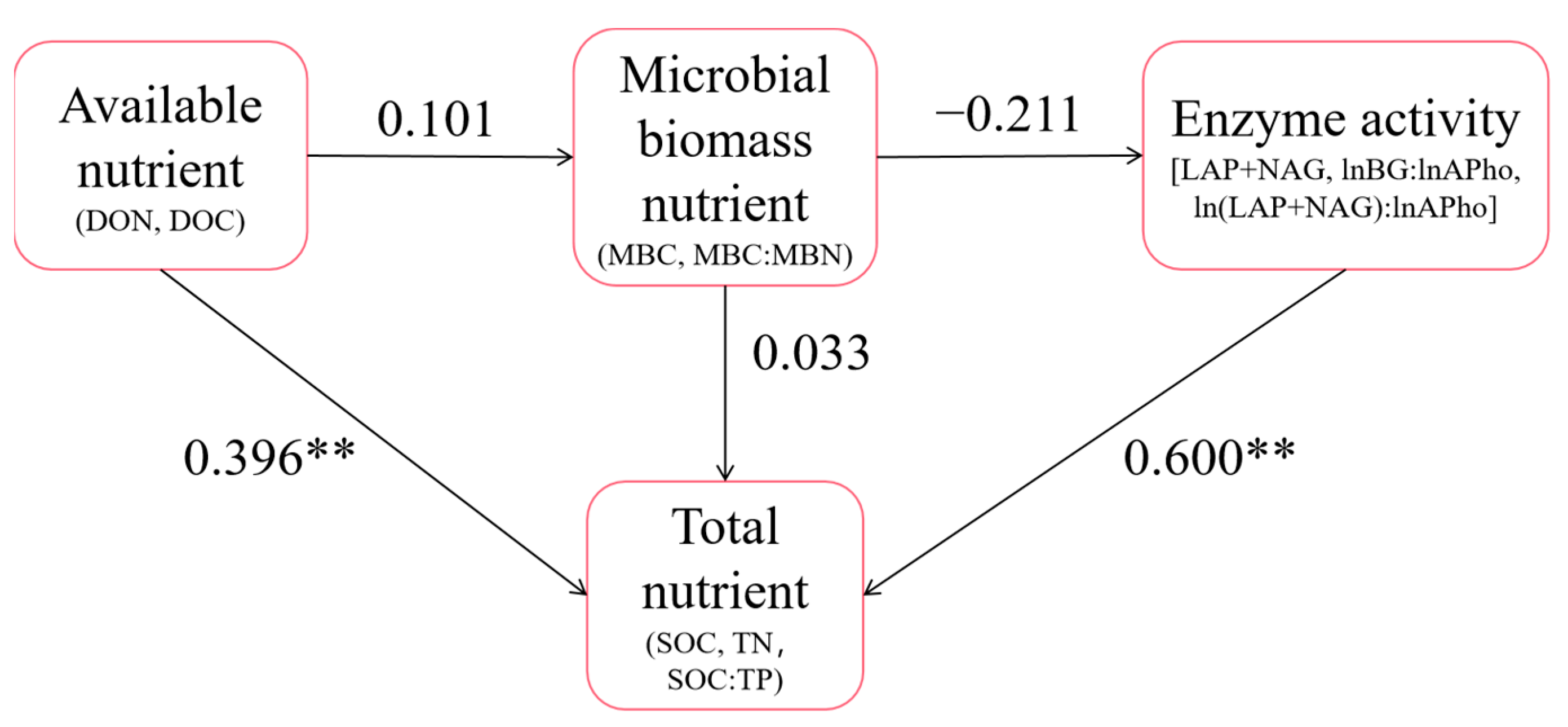Effects of Different Forest Types on Stoichiometric Characteristics of Carbon, Nitrogen, and Phosphorus in Tropical Soils, China
Abstract
1. Introduction
2. Materials and Methods
2.1. The Description of the Study Site
2.2. Soil Sampling and Analysis
2.3. Data Analysis
3. Results
3.1. SOC, TN, TP, and Stoichiometric Characteristics
3.2. DOC, DON, AP, and Stoichiometric Characteristics
3.3. MBC, MBN, MBP, and Stoichiometric Characteristics
3.4. Soil Ecological Enzyme Activity and Stoichiometric Characteristics
3.5. SEM of Each Index
3.6. The Results of Linear Regression Analysis and the F Values of the Effect of Forest Type on the Ratio of C, N, and P
4. Discussion
4.1. Effects of Different Forest Types on Soil SOC, TN, TP, and Stoichiometric Characteristics
4.2. Effects of Different Forest Types on Soil DOC, DON, AP, and Stoichiometric Characteristics
4.3. Effects of Different Forest Types on Soil MBC, MBN, MBP, and Stoichiometric Characteristics
4.4. Effects of Different Forest Types on Soil BG, (LAP + NAG), APho Activities, and Stoichiometric Characteristics
5. Conclusions
Supplementary Materials
Author Contributions
Funding
Institutional Review Board Statement
Informed Consent Statement
Data Availability Statement
Conflicts of Interest
References
- Wang, W.; Peng, Y.; Chen, Y.; Lei, S.; Wang, X.; Farooq, T.H.; Liang, X.; Xhang, C.; Yan, W.; Chen, X. Ecological Stoichiometry and Stock Distribution of C, N, and P in Three Forest Types in a Karst Region of China. Plants 2023, 12, 2503. [Google Scholar] [CrossRef] [PubMed]
- Heinrich, V.H.A.; Vancutsem, C.; Dalagnol, R.; Rosan, T.M.; Fawcett, D.; Silva-Junior, C.H.L.; Cassol, H.L.G.; Achard, F.; Jucker, T.; Silva, C.A.; et al. The carbon sink of secondary and degraded humid tropical forests. Nature 2023, 615, 436–442. [Google Scholar] [CrossRef] [PubMed]
- Mitchard, E. The tropical forest carbon cycle and climate change. Nature 2018, 559, 527–534. [Google Scholar] [CrossRef] [PubMed]
- Gatti, L.V.; Basso, L.S.; Miller, J.B.; Gloor, M.; Gatti Domingues, L.; Cassol, H.L.G.; Tejada, G.; Aragão, L.E.O.C.; Nobre, C.; Peters, W.; et al. Amazonia as a carbon source linked to deforestation and climate change. Nature 2021, 595, 388–393. [Google Scholar] [CrossRef]
- Lu, J.; Feng, S.; Wang, S.; Zhang, B.; Ning, Z.; Wang, R.; Chen, X.; Yu, L.; Zhao, H.; Lan, D.; et al. Patterns and driving mechanism of soil organic carbon, nitrogen, and phosphorus stoichiometry across northern China’s desert-grassland transition zone. Catena 2023, 220, 106695. [Google Scholar] [CrossRef]
- Qi, D.; Feng, F.; Lu, C.; Fu, Y. C:N:P stoichiometry of different soil components after the transition of temperate primary coniferous and broad-leaved mixed forests to secondary forests. Soil Tillage Res. 2022, 216, 105260. [Google Scholar] [CrossRef]
- Zhang, J.; Li, M.; Xu, L.; Zhu, J.; Dai, G.; He, N. C:N:P stoichiometry in terrestrial ecosystems in China. Sci. Total Environ. 2021, 795, 148849. [Google Scholar] [CrossRef]
- Tao, Y.; Zhou, X.-B.; Zhang, S.-H.; Lu, H.-Y.; Shao, H. Soil nutrient stoichiometry on linear sand dunes from a temperate desert in Central Asia. Catena 2020, 195, 104847. [Google Scholar] [CrossRef]
- Wei, X.; Zhu, Z.; Liu, Y.; Luo, Y.; Deng, Y.; Xu, X.; Liu, S.; Richter, A.; Shibistova, O.; Guggenberger, G.; et al. C:N:P stoichiometry regulates soil organic carbon mineralization and concomitant shifts in microbial community composition in paddy soil. Biol. Fertil. Soils 2020, 56, 1093–1107. [Google Scholar] [CrossRef]
- Guo, Z.; Wang, Y.; Wan, Z.; Zuo, Y.; He, L.; Li, D.; Yuan, F.; Wang, N.; Liu, J.; Song, Y.; et al. Soil dissolved organic carbon in terrestrial ecosystems: Global budget, spatial distribution and controls. Glob. Ecol. Biogeogr. 2020, 29, 2159–2175. [Google Scholar] [CrossRef]
- He, Y.; Sun, J.; Xiong, J.; Shang, H.; Wang, X. Patterns, Dynamics, and Drivers of Soil Available Nitrogen and Phosphorus in Alpine Grasslands across the QingZang Plateau. Remote Sens. 2022, 14, 4929. [Google Scholar] [CrossRef]
- Terrer, C.; Jackson, R.B.; Prentice, I.C.; Keenan, T.F.; Kaiser, C.; Vicca, S.; Fisher, J.B.; Reich, P.B.; Stocker, B.D.; Hungate, B.A.; et al. Nitrogen and phosphorus constrain the CO2 fertilization of global plant biomass. Nat. Clim. Chang. 2019, 9, 684–689. [Google Scholar] [CrossRef]
- Wang, X.; Zheng, M.; Zhang, Y.; Chen, Y.; Zhao, L.; Chai, B.; Jia, T. Stoichiometric Soil Microbial and Enzymatic Characteristics under Three Different Plantation Types in China’s Luya Mountain. Forests 2023, 14, 558. [Google Scholar] [CrossRef]
- Zhou, Z.; Wang, C.; Luo, Y. Response of soil microbial communities to altered precipitation: A global synthesis. Glob. Ecol. Biogeogr. 2018, 27, 1121–1136. [Google Scholar] [CrossRef]
- Zheng, H.F.; Vesterdal, L.; Schmidt, I.K.; Rousk, J. Ecoenzymatic stoichiometry can reflect microbial resource limitation, substrate quality, or both in forest soils. Soil Biol. Biochem. 2022, 167, 108613. [Google Scholar] [CrossRef]
- Xiao, X.Q.; Zhang, H.K.; Feng, Y.S.; Wang, J.P.; Liang, C.F.; Chen, Y.C.; Zhu, G.D.; Cai, Y.J. Effects of plant residues on C:N:P of soil, microbial biomass, and extracellular enzyme in an alpine mea-dow on the Qinghai-Tibetan Plateau, China. Ying Yong Sheng Tai Xue Bao = J. Appl. Ecol. 2023, 34, 58–66. [Google Scholar] [CrossRef]
- Cleveland, C.C.; Liptzin, D. C:N:P stoichiometry in soil: Is there a “Redfield ratio” for the microbial biomass? Biogeochemistry 2007, 85, 235–252. [Google Scholar] [CrossRef]
- Kirkby, C.A.; Kirkegaard, J.A.; Richardson, A.E.; Wade, L.J.; Blanchard, C.; Batten, G. Stable soil organic matter: A comparison of C:N:P:S ratios in Australian and other world soils. Geoderma 2011, 163, 197–208. [Google Scholar] [CrossRef]
- Bui, E.N.; Henderson, B.L. C:N:P stoichiometry in Australian soils with respect to vegetation and environmental factors. Plant Soil 2013, 373, 553–568. [Google Scholar] [CrossRef]
- Li, Y.; Wu, J.; Liu, S.; Shen, J.; Huang, D.; Su, Y.; Wei, W.; Syers, J.K. Is the C:N:P stoichiometry in soil and soil microbial biomass related to the landscape and land use in southern subtropical China? Glob. Biogeochem. Cycles 2012, 26, GB4002. [Google Scholar] [CrossRef]
- Yu, Z.; Wang, M.; Huang, Z.; Lin, T.C.; Vadeboncoeur, M.A.; Searle, E.B.; Chen, H.Y. Temporal changes in soil C-N-P stoichiometry over the past 60 years across subtropical China. Glob. Chang. Biol. 2018, 24, 1308–1320. [Google Scholar] [CrossRef] [PubMed]
- Zhang, W.; Liu, W.; Xu, M.; Deng, J.; Han, X.; Yang, G.; Feng, Y.; Ren, G. Response of forest growth to C:N:P stoichiometry in plants and soils during Robinia pseudoacacia afforestation on the Loess Plateau, China. Geoderma 2019, 337, 280–289. [Google Scholar] [CrossRef]
- Zhou, Z.; Jiang, L.; Du, E.; Hu, H.; Li, Y.; Chen, D.; Fang, J. Temperature and substrate availability regulate soil respiration in the tropical mountain rainforests, Hainan Island, China. J. Plant Ecol. 2013, 6, 325–334. [Google Scholar] [CrossRef]
- Jiang, L.; Ma, S.; Zhou, Z.; Zheng, T.; Jiang, X.; Cai, Q.; Li, P.; Zhu, J.; Li, Y.; Fang, J. Soil respiration and its partitioning in different components in tropical primary and secondary mountain rain forests in Hainan Island, China. J. Plant Ecol. 2016, 10, 791–799. [Google Scholar] [CrossRef]
- Chen, D.; Li, Y.; Liu, H.; Xu, H.; Xiao, W.; Luo, T.; Zhou, Z.; Lin, M. Biomass and carbon dynamics of a tropical mountain rain forest in China. Sci. China Life Sci. 2010, 53, 798–810. [Google Scholar] [CrossRef]
- Richard, H.L.; Donald, L.S. Soil Science of America and American Society of Agronomy; Book Series No. 5; Madison, WI, USA, 1996; Available online: https://acsess.onlinelibrary.wiley.com/doi/book/10.2136/sssabookser5.3 (accessed on 10 December 2023).
- Parkinson, J.; Allen, S. A Wet Oxidation Procedure for Determination of Nitrogen and Mineral Nutrients in Biological Material. Commun. Soil Sci. Plant Anal. 1975, 6, 1–11. [Google Scholar] [CrossRef]
- Schoenau, J.; Huang, W. Anion-exchange membrane, water, and sodium bicarbonate extractions as soil tests for phosphorus. Commun. Soil Sci. Plant Anal. 1991, 22, 465–492. [Google Scholar] [CrossRef]
- Vance, E.; Brookes, P.C.; Jenkinson, D.S. Microbial biomass measurements in forest soils: Determination of kC values and tests of hypotheses to explain the failure of the chloroform fumigation-incubation method in acid soils. Soil Biol. Biochem. 1987, 19, 689–696. [Google Scholar] [CrossRef]
- Anderson, J.P.; Domsch, K.H. A physiological method for the quantitative measurement of microbial biomass in soils. Soil Biol. Biochem. 1978, 10, 215–221. [Google Scholar] [CrossRef]
- Burns, R.G. Soil Biology & Biochemistry Citation Classics. Soil Biol. Biochem. 2004, 36, 3. [Google Scholar] [CrossRef]
- Saiya-Corka, K.R.; Sinsabaugha, R.L.; Zakb, D.R. The effects of long term nitrogen deposition on extracellular enzyme activity in an Acer saccharum forest soil. Soil Biol. Biochem. 2002, 34, 1309–1315. [Google Scholar] [CrossRef]
- Zhuang, P. Studies on Diversity of Endophytic Bacteria in the Nodule of Podocarpus imbricatus. Master’s Thesis, Guangxi University, Nanning, China, 2006. Available online: https://www.xueweilunwen.com/doc/512927 (accessed on 10 December 2023).
- Li, Z.; Chen, S.; Zhou, Y.; Zhong, X. Study on soil fertility change of Pinus caribaea Morelet after afforestation. Guangdong For. Technol. 2005, 21, 30–33. Available online: https://xueshu.baidu.com/usercenter/paper/show?paperid=195c0m20ur0j08x0vh6f0670j6313904&site=xueshu_se (accessed on 10 December 2023).
- Tian, H.; Chen, G.; Zhang, C.; Melillo, J.M.; Hall CA, S. Pattern and variation of C:N:P ratios in China’s soils: A synthesis of observational data. Biogeochemistry 2009, 98, 139–151. [Google Scholar] [CrossRef]
- Zhang, J.; Zhao, N.; Liu, C.; Yang, H.; Li, M.; Yu, G.; Wilcox, K.; Yu, Q.; He, N. C:N:P stoichiometry in China’s forests: From organs to ecosystems. Funct. Ecol. 2018, 32, 50–60. [Google Scholar] [CrossRef]
- Shi, Y.Y.; Deng, M.J.; Jian, T.; Song, X.C.; Wang, H.L.; Qin, Q.Y. Forest soil nutrient classification method based on spatial analysis. Pratacult. Sci. 2016, 33, 1112–1117. [Google Scholar] [CrossRef]
- Li, J.; Lan, G.Y.; Li, Y.-W. Comparative Studies on Soil Microbial Biomass Carbon in Rubber Forest and Secondary Forest in Danzhou, Hainan Province. 2016. Available online: https://xueshu.baidu.com/usercenter/paper/show?paperid=2ef1c7b294322475fcfe06e303823c09&site=xueshu_se&hitarticle=1 (accessed on 10 December 2023).
- Zhang, W.; Xu, Y.; Gao, D.; Wang, X.; Liu, W.; Deng, J.; Han, X.; Yang, G.; Feng, Y.; Ren, G. Ecoenzymatic stoichiometry and nutrient dynamics along a revegetation chronosequence in the soils of abandoned land and Robinia pseudoacacia plantation on the Loess Plateau, China. Soil Biol. Biochem. 2019, 134, 1–14. [Google Scholar] [CrossRef]
- Zhou, L.; Liu, S.; Shen, H.; Zhao, M.; Xu, L.; Xing, A.; Fang, J. Soil extracellular enzyme activity and stoichiometry in China’s forests. Funct. Ecol. 2020, 34, 1461–1471. [Google Scholar] [CrossRef]









| Forest Type | Primary Forest | Secondary Forest | Dacrycarpus imbricatus | Pinus caribaea Morelet |
|---|---|---|---|---|
| Soil water content | 0.18 | 0.24 | 0.22 | 0.22 |
| Soil bulk density g/cm3 | 1.00 | 0.90 | 0.84 | 1.11 |
| Soil pH | 4.80 | 4.82 | 4.44 | 4.50 |
| Factor | F Values | |||||||||||
|---|---|---|---|---|---|---|---|---|---|---|---|---|
| Soil C:N | Soil C:P | Soil N:P | DOC: DON | DOC: AP | DON: AP | MBC: MBN | MBC: MBP | MBN: MBP | lnBG: ln(LAP + NAG) | lnBG: lnAPho | ln(LAP + NAG): lnAPho | |
| Forest type (0–10 cm) | 34.9 ** | 22.1 ** | 29.3 ** | 241.9 ** | 193.1 ** | 60.5 ** | 1834.8 ** | 7707.0 ** | 796.6 ** | 30.5 ** | 274.2 ** | 196.0 ** |
| Forest type (10–20 cm) | 55.1 ** | 17.6 ** | 46.1 ** | 469.4 ** | 279.7 ** | 668.9 ** | 1336.4 ** | 1199.3 ** | 2315.3 ** | 105.6 ** | 220.9 ** | 263.0 ** |
| Forest type (20–30 cm) | 162.4 ** | 50.9 ** | 86.5 ** | 3.9 | 73.2 ** | 32.2 ** | 3456.3 ** | 2713.6 ** | 1687.1 ** | 153.8 ** | 95.5 ** | 105.9 ** |
Disclaimer/Publisher’s Note: The statements, opinions and data contained in all publications are solely those of the individual author(s) and contributor(s) and not of MDPI and/or the editor(s). MDPI and/or the editor(s) disclaim responsibility for any injury to people or property resulting from any ideas, methods, instructions or products referred to in the content. |
© 2024 by the authors. Licensee MDPI, Basel, Switzerland. This article is an open access article distributed under the terms and conditions of the Creative Commons Attribution (CC BY) license (https://creativecommons.org/licenses/by/4.0/).
Share and Cite
Liu, H.; Qi, J.; Liu, D.; Yang, J.; Chen, M.; Li, S.; Li, C.; Li, C. Effects of Different Forest Types on Stoichiometric Characteristics of Carbon, Nitrogen, and Phosphorus in Tropical Soils, China. Sustainability 2024, 16, 480. https://doi.org/10.3390/su16020480
Liu H, Qi J, Liu D, Yang J, Chen M, Li S, Li C, Li C. Effects of Different Forest Types on Stoichiometric Characteristics of Carbon, Nitrogen, and Phosphorus in Tropical Soils, China. Sustainability. 2024; 16(2):480. https://doi.org/10.3390/su16020480
Chicago/Turabian StyleLiu, Hong, Jincun Qi, Daquan Liu, Jiwei Yang, Mingwan Chen, Shoupeng Li, Changjiang Li, and Changzhen Li. 2024. "Effects of Different Forest Types on Stoichiometric Characteristics of Carbon, Nitrogen, and Phosphorus in Tropical Soils, China" Sustainability 16, no. 2: 480. https://doi.org/10.3390/su16020480
APA StyleLiu, H., Qi, J., Liu, D., Yang, J., Chen, M., Li, S., Li, C., & Li, C. (2024). Effects of Different Forest Types on Stoichiometric Characteristics of Carbon, Nitrogen, and Phosphorus in Tropical Soils, China. Sustainability, 16(2), 480. https://doi.org/10.3390/su16020480





